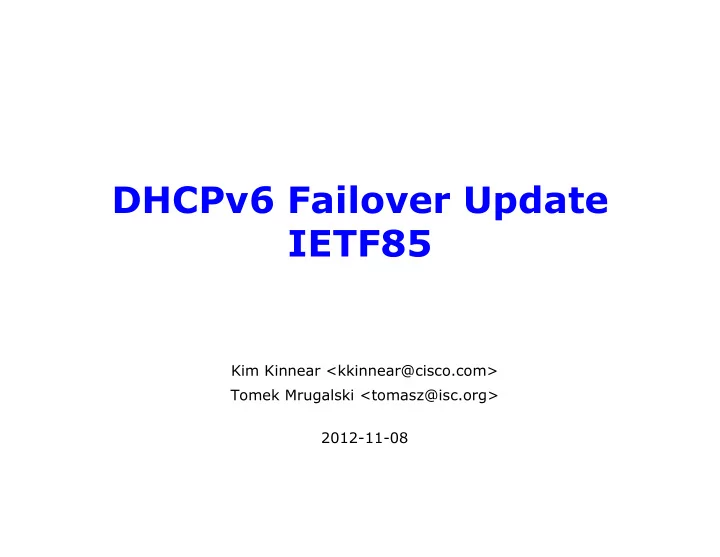

DHCPv6 Failover Update IETF85 Kim Kinnear <kkinnear@cisco.com> Tomek Mrugalski <tomasz@isc.org> 2012-11-08
DHCPv6 Failover Grand Plan • Step 0: Redundancy considerations – Submitted -03 that addresses raised IESG issues (done?) – Waiting for IESG to proceed • Step 1: Requirements document (info) – WGLC in progress – Received several comments (clarification style) – Publish -03 • Step 2: Design document (std) – WG item, published -02 – Text complete (no major missing parts) – Asking for review/comments • Step 3: Protocol document (std) – Todo • Possible extension drafts
DHCPv6 Failover Requirements • WGLC announced Oct. 22, end by Nov. 12 • No comments so far draft-ietf-dhc-dhcpv6-failover-requirements-02
DHCPv6 Failover Design Overview l -02 posted on Oct. 22, 2012 l Fulfills all requirements specified in failover- requirements-02 l Based on v4 failover draft, but simplified l Hot standby (Active-passive only) l No load balancing in design spec l likely extension l some provisioning ready l common state machine for base and load balancing draft-ietf-dhc-dhcpv6-failover-design-02
DHCPv6 Failover Design Major Concepts / Sections l Lazy Updates for performance -> MCLT l Failover Endpoint state machine l Lease state machine additions l Binding updates + conflict resolution l TCP Connection management l 2 Resource Allocation Algorithms l Proportional l Independent l DDNS considerations l Lease reservation
DHCPv6 Failover Design Communication • Communication over TCP • Reuse bulk leasequery framing, with new failover specific message types • TLS usage (optional)
DHCPv6 Failover Design Messages Connection management: CONNECT, CONNECTACK, DISCONNECT State notifications: STATE Individual Lease updates: BNDUPD, BNDACK Lease Update Requests: UPDREQ, UPDREQALL, UPDDONE Pool requests: POOLREQ, POOLRESP Application level keep alive: CONTACT
DHCPv6 Failover Design Resource Allocation Two algorithms defined Proportional allocation (“IPv4 failover-style”) 1. Pool may need to be rebalanced. 2. Only unleased resources are owned by specific server. 3. Useful for limited resources (e.g. prefixes) 4. Released/expired resources return to primary
DHCPv6 Failover Design Resource Allocation Independent allocation (“simple split”) 1. Useful for vast resources (e.g. /64 address pool) 2. All resources are owned by specific server. 3. Pools are never rebalanced. 4. Released/expired resources return to its owner. 5. Simpler, but MCLT restrictions still apply.
DHCPv6 Failover Design Synchronized Update DHCPv6 Client DHCPv6 Server Failover Partner SOLICIT ADVERTISE BNDUPD Time? BNDACK REQUEST REPLY
DHCPv6 Failover Design Lazy update DHCPv6 Client DHCPv6 Server Failover Partner SOLICIT ADVERTISE REQUEST Crash? REPLY BNDUPD BNDACK
DHCPv6 Failover Design Maximum Client Lease Time (MCLT) The maximum difference between lease time known by a client and the lease time acknowledged by the failover partner. Useful in communications-interrupted l Server does not know if its partner extended any lease l It knows that its partner could extend by at most MCLT l To be on the safe side, server assumes that ALL leases were extended by MCLT.
Failover Endpoint (partner) State Machine responsive RECOVER RECOVER RECOVER unresponsive DONE WAIT Other state: CONFLICT NORMAL DONE NORMAL resolves NORMAL, COMM-INT STARTUP Comm ok, other state: Primary Comm.ok, otherstate: conflict RECOVER, wait for RECOVER-DONE Communication failed POTENTIAL CONFLICT PARTNER Comm. Timer or Comm. Fail DOWN OK admin action COMM. INTERRUPTED RESOLUTION Comm. ok INTERRUPTED admin action
DHCPv6 Failover Design Next steps 1. Comments are more than welcome 2. Working toward WGLC (needs more review) 3. Start work on protocol draft details (messages, options)
Thank you
Backup
MCLT example Cast: Client, Server, (Failover) Partner Valid lifetime = 3 days, MCLT = 1 hour 1. Client asks for an address. 2. Partner ack'd lease time is 0. 3. Client gets 0+MCLT = 1 hour 4. Server updates its partner with 3 days + ½ hour. 5. Partner acks. 6. 30 minutes passes and client renews. 7. Partner's ack'd time is 3 days now. 8. Client receives renewed lease with valid lifetime 3 days. 9. Server updates its partner with expected renewal time (0,5*3 days) + desired potential valid lifetime (3 days) = 4,5 days. 10. Partner acks. Ack'd lease time is 4,5 days. 11. Client renews in 1,5 days and steps 7-10 repeat.
Recommend
More recommend